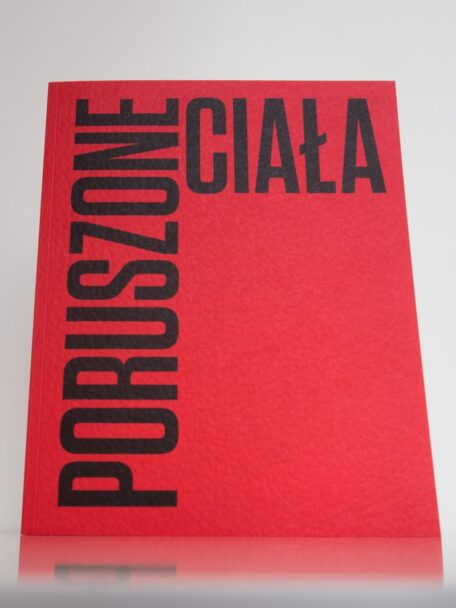
Photo: Julia Kostarska-Talaga.
We are pleased to announce that Muzeum Sztuki in Łódź has just released a new collection of essays Moved Bodies. Choreographies of Modernity edited by Katarzyna Słoboda. Made up of contributions in Polish and English, this bilingual publication has been issued in the aftermath of the eponymous conference held at Muzeum Sztuki in Łódź at the turn of 2016 and 2017, and the How Does the Body Think? Corporeal and Movement Based Practices of Modernism and Modernity conference (3-4 December 2016), co-organised by professor Małgorzata Leyko of the Institute of Contemporary Culture at the University of Łódź.
The collection opens with a visual essay documenting the exhibition (whose scenography was created by Karolina Fandrejewska) and performances that were an essential part of the project, as well as an essay written as an overview to the artistic (or, more broadly, the cultural), social and political themes which were the focus of the exhibition. The publication includes texts by renowned scholars of modern dance (?).
The successive texts by Professor Susan Manning and Hanna Raszewska are concerned with, respectively, the global and local trajectories of the development of modern dance; the reception and perception contexts of dance juxtaposed with the stage practices of the Weimar Republic (Dr Kate Elswit;, the kinesthetic dimension of the natural sciences and technology in the early 20th century (Prof. Inge Baxmann); the corporeal aspects of thinking which set new directions for the reflection on women?s history (Prof. Felicia McCarren); the social functions of rhythm in dance theories and practices of modernism (Dr hab. Wojciech Klimczyk); dance as work from the political and philosophical perspective (Prof. Mark Franko); finally, the relations of modern dance and the early feminist movements (Julia Hoczyk). The volume concludes with two essays complementing the range of issues presented by the exhibition: a translation of the article by Prof. Nell Andrew, who treats the case of Akarova (a Belgian dancer and choreographer) as a way to discuss the relations between the visual arts, dance, theatre, architecture and music, followed by Małgorzata Jędrzejczyk?s essay on the contexts and relations of space and movement of the body in the sculptural theory and practice of Katarzyna Kobro. The exhibition, the conference, and the volume raise questions about the corporeal and movement based experience of modernity in the context of artistic and social practices. The book will hopefully help to revive the debate upon the kinesthetic conditioning of the modernist project, while also introducing dance and choreographic practices into the context of a broader reflection on modern art.
Moved Bodies. Choreographies of Modernity
Editor: Katarzyna Słoboda
Contributros: Nell Andrew, Inge Baxmann, Kate Elswit, Mark Franko, Julia Hoczyk, Małgorzata Jędrzejczyk, Wojciech Klimczyk, Susan Manning, Felicia McCarren, Hanna Raszewska, Katarzyna Słoboda
Excerpt from a review by prof. Dariusz Kosiński:
Muzeum Sztuki in Łódź is not only known for its remarkable and salient exhibitions but also for its equally remarkable and significant publications, which with increasing audacity (and in line with the trend that can be observed in contemporary culture) venture beyond visual arts. When crossing the borders of the visual arts, Muzeum Sztuki in its activities is increasingly and more daringly drifting towards dance. Moved Bodies. Choreographies of Modernity is yet another step, following the recently published You Come, We?ll Show You What We Do. On Dance Improvisation (Łódź 2013). It is a powerful work, which shows that this is the right direction to follow. It complements the exhibition of the same title and proceeds from the conference How Does the Body Think? Corporeal and Movement Based Practices of Modernism. (?) The titles from both events preceding the book which are documented in it delineate its specific focus and identify two principal routes along which the book takes us: choreographical-historic and philosophical-political. In brief, we might say that the former book guides us through considerations over the question ?What would move bodies in the first half of the 20th century??, while the latter one takes us to the heart of the fundamental issue addressed in the title of the conference: ?how does the body think??. The journeys along these paths often overlap and at times develop almost in parallel, which is a truly fascinating experience revealing unexpected and alluring perspectives.
(?) The book clearly and manifestly shows that dance offers new approaches to thinking about performances as well as new research methods, which obviously originate from the body and from thinking in terms of the body rather than language. For many dance enthusiasts the publication will serve not only as an encouragement to search for new methodologies but also as a demonstration of how these methodologies work and what tangible research outcomes they can produce. To the humanists who (despite declaring their moving away from logocentrism) are still trapped in the realm of language and text as primary metaphorical expressions of thoughts, Moved Bodies. Choreographies of Modernity may become a jealousy inducing and yet inspiring read that encourages the practice they so passionately discuss.
The book is available at the Muzeum Sztuki in Łódź bookshop:
http://msl.org.pl/ms/ksiegarnia/poruszone-ciala–choreografie-nowoczesnosci,247.html
About the exhibition: